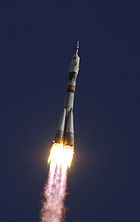Vostok-2M
 Vostok-2M rocket | |
| Function | Carrier rocket |
|---|---|
| Manufacturer | OKB-1 |
| Country of origin | |
| Size | |
| Stages | Two |
| Capacity | |
| Payload to SSO | |
| Mass | 3,800 kilograms (8,400 lb) |
| Associated rockets | |
| Family | R-7 |
| Launch history | |
| Status | Retired |
| Launch sites | Baikonur Site 31/6 Plesetsk Site 41/1 & 43 |
| Total launches | 93 |
| Success(es) | 92 |
| Failure(s) | 1 |
| First flight | 28 August 1964 |
| Last flight | 29 August 1991 |
| Type of passengers/cargo | Meteor Resurs Tselina-D |
| Boosters | |
| No. boosters | 4 |
| Powered by | 1 RD-107-8D74K |
| Maximum thrust | 995.3 kilonewtons (223,800 lbf) |
| Burn time | 120 seconds |
| Propellant | RP-1/LOX |
| First stage | |
| Powered by | 1 RD-108-8D75K |
| Maximum thrust | 940.4 kilonewtons (211,400 lbf) |
| Burn time | 305 seconds |
| Propellant | RP-1/LOX |
| Second stage | |
| Powered by | 1 RD-0109 |
| Maximum thrust | 54.52 kilonewtons (12,260 lbf) |
| Burn time | 400 seconds |
| Propellant | RP-1/LOX |
The Vostok-2M (Russian: Восток meaning "East"), GRAU index 8A92M was an expendable carrier rocket used by the Soviet Union between 1964 and 1991. Ninety-three were launched, of which one failed. Another was destroyed before launch.[1] It was originally built as a specialised version of the earlier Vostok-2, for injecting lighter payloads into higher sun-synchronous orbits. It was a member of the R-7 family of rockets, and the last Vostok.
The Vostok-2M made its maiden flight on 28 August 1964, from Site 31/6 at the Baikonur Cosmodrome, successfully placing Kosmos 44, a Meteor weather satellite into orbit. Its only launch failure occurred on 1 February 1969, when the launch of a Meteor failed due to an upper stage problem.
At 16:01 GMT on 18 March 1980, a Vostok-2M exploded during fueling Plesetsk Site 43/4, ahead of the launch of a Tselina-D satellite, killing 48 people who were working on the rocket at the time. A filter in a hydrogen peroxide tank of the third stage had accidentally been soldered with tin-lead, the latter of which causes decomposition of hydrogen peroxide.[2] As a consequence, the H2O2 broke down, overheated, and melted the solder, causing pieces to fall into the H2O2 storage tank and cause a runaway chemical reaction. This led to a fire inside the third stage and eventual explosion which resulted in the complete destruction of the launch vehicle and severe pad damage (LC-43 did not host another launch for three years).
Vostok-2M launches occurred from Site 31/6 at Baikonur, and Sites 41/1 and 43 at Plesetsk. It is unclear if any were launched from Site 1/5 at Baikonur. The Vostok-2M was retired in 1991, in favour of standardisation on the Soyuz-U and U2 rockets. The final flight was conducted on 29 August, and carried the IRS-1B satellite for the Indian Space Research Organisation.
References
- ^ Wade, Mark. "Vostok 8A92M". Encyclopedia Astronautica. Retrieved 2009-04-15.
- ^ Boris Yevseyevich Chertok (2006-06-01). "Rockets and People: Creating a rocket industry" (PDF). Government Printing Office: 636–640. ASIN B019NDFEHI. ISBN 9780160766725.
{{cite journal}}: Cite has empty unknown parameter:|naid=(help); Cite journal requires|journal=(help)

